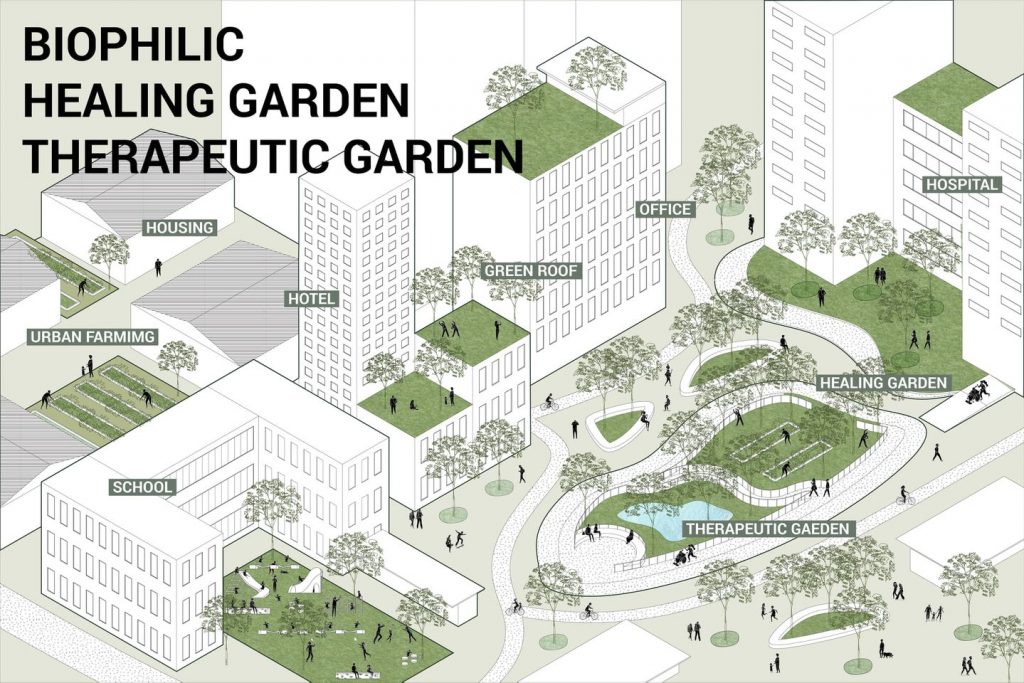
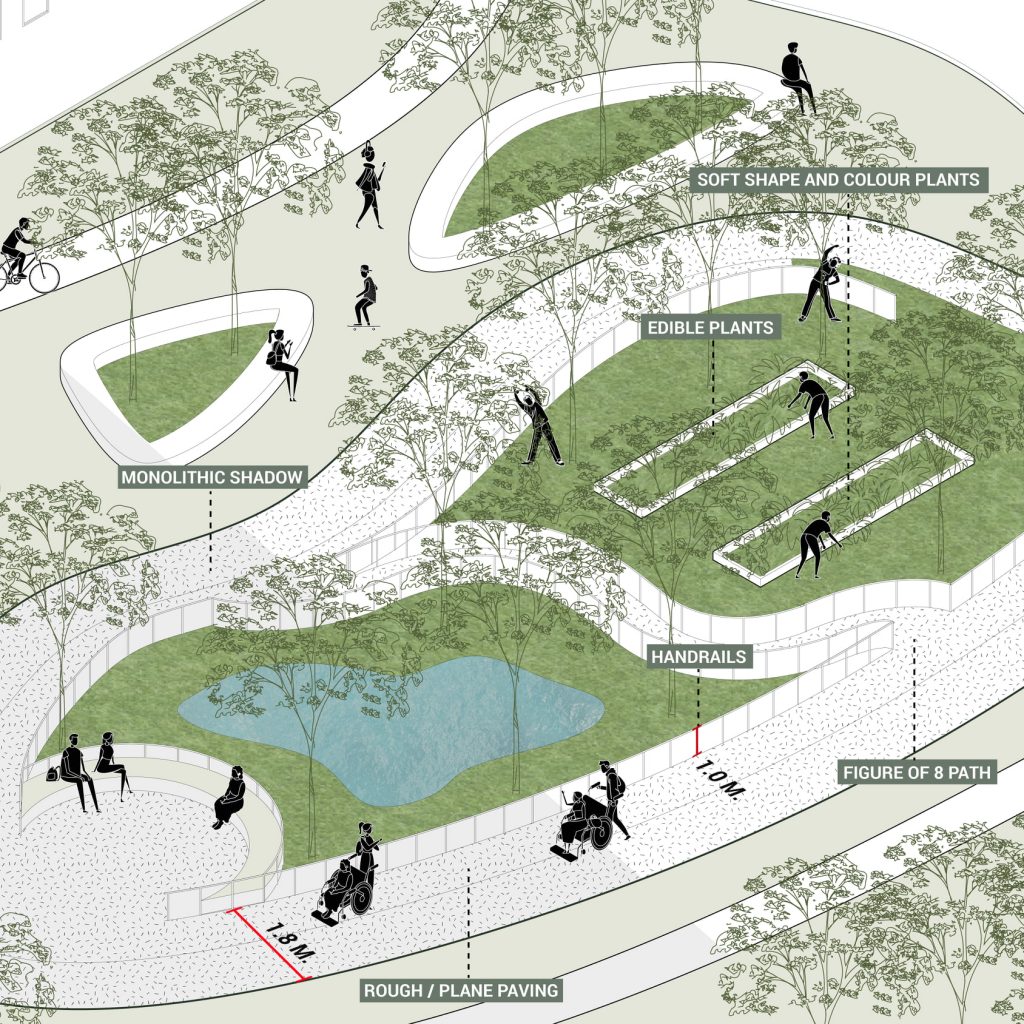
1 Healing Garden and Therapeutic Garden
.
[Please scroll down for English Translation]
.
จากวิวัฒนาการเราได้เรียนรู้ว่ามนุษย์ประสบกับปันหาความเครียดในทุกวันทั้งทางร่างกายและจิตใจ จากงานวิจัยจำนวนมากพบว่าสภาพแวดล้อมในการทำงานมีผลอย่างมากต่อประสิทธิภาพการทำงานของเรา การได้สัมผัสกับธรรมชาติแม้เพียงเล็กน้อยช่วยส่งเสริมคุณภาพชีวิตของเราได้ แนวคิดนี้เองสามารถถูกนำไปใช้ในการออกแบบสวนสุขภาพ (Healing Garden) และสวนส่งเสริมทางการแพทย์ (Therapeutic Garden) มาถึงตรงนี้คงสงสัยกันแล้วว่าสวนทั้งสองแบบที่ว่ามีหน้าตาและคุณสมบัติเป็นอย่างไร เพราะอันที่จริงๆทั้งคู่ต่างก็เป็นสวนที่ออกแบบมาเพื่อเอื้อความรู้สึกสบายให้กับผู้มาใช้งาน
.
สวนสุขภาพ หรือ Healing Garden มีวัตถุประสงค์เพื่อบรรเทาความเครียดและส่งเสริมกิจกรรมทางสังคม มีการวางแผนโซนต่างๆ ตลอดเส้นทาง เพื่อให้ผู้ใช้งานได้สัมผัสและมีส่วนร่วมในกิจกรรมที่แตกต่างกันไป องค์ประกอบของสวนรักษา มี 2 ประเภทหลักคือ สวนแห่งความสามารถ (Enabling Garden) ที่เปิดโอกาสให้มีการปฏิสัมพันธ์ทางสังคม และ สวนฟื้นฟูสมรรถภาพ (Restorative Garden) ซึ่งเป็นพื้นที่ฟื้นฟูจิตใจ
.
ในขณะที่สวนส่งเสริมทางการแพทย์ หรือ Therapeutic Garden เป็นสวนที่ถูกใช้สำหรับการบำบัดทางการแพทย์โดยเฉพาะ รองรับผู้ที่มีความต้องการทางการรักษาเป็นพิเศษ ดังนั้นจึงออกมาในรูปแบบที่มีทางเข้าที่เข้าถึงได้ง่ายกว่า มีเส้นทางเดินที่จำง่าย ทุกองค์ประกอบล้วนถูกออกแบบอย่างรอบคอบและละเอียดอ่อนมากกว่า สวนประเภทนี้ได้รับการพิสูจน์แล้วว่าสามารถรักษาสภาพจิตใจของผู้ป่วยได้ในระยะยาว รวมถึงผู้ที่มีอาการทางจิตใจและอัลไซเมอร์
.
แน่นอนว่าสำหรับโครงการของฉมาเอง เราได้มีการปรับใช้แนวคิดนี้ มีการออกแบบโดยคำนึงถึง อากาศ อุณหภูมิ น้ำ และแสง พร้อมอิงประสาทสัมผัสของมนุษย์เช่นกัน มาดูกันดีกว่าว่าเป็นอย่างไรบ้าง
—
Through years of evolution, we have learned that humanities experiences stress daily both physically and mentally. Research has shown that the working environment greatly affects our productivity. Experiencing even the tiniest glimpse of nature will majorly increase our living quality. Hence leading towards Healing Garden and Therapeutic Garden designs. So, what are they? Healing Gardens and Therapeutic Gardens are gardens designed to give comfort to users.
.
Healing Gardens are aimed to reduce stress and encourage social activities. Different momentums and settings are planned along the path to allow users to experience certain levels of exposure to participation. A composition of 2 main types of settings; Enabling Gardens which allows for interaction between society and Restorative Gardens which is a mental restoration space.
.
Therapeutic Gardens, however, are used as a tool for medical therapy. They are directly aimed towards those in need of special medical treatments. With a much more accessible entrance and easily navigable path considered, Therapeutic Gardens have to be much more carefully thought out with sensitive details throughout the design process. These gardens have proven to heal the mental state of long-term patients and those with psychological symptoms and Alzheimers.
.
The consideration of designing with the presence of air, temperature, water, and light along the lines of the human sensory palette has been taken into our design projects. So, let’s see some of Shma’s design examples.
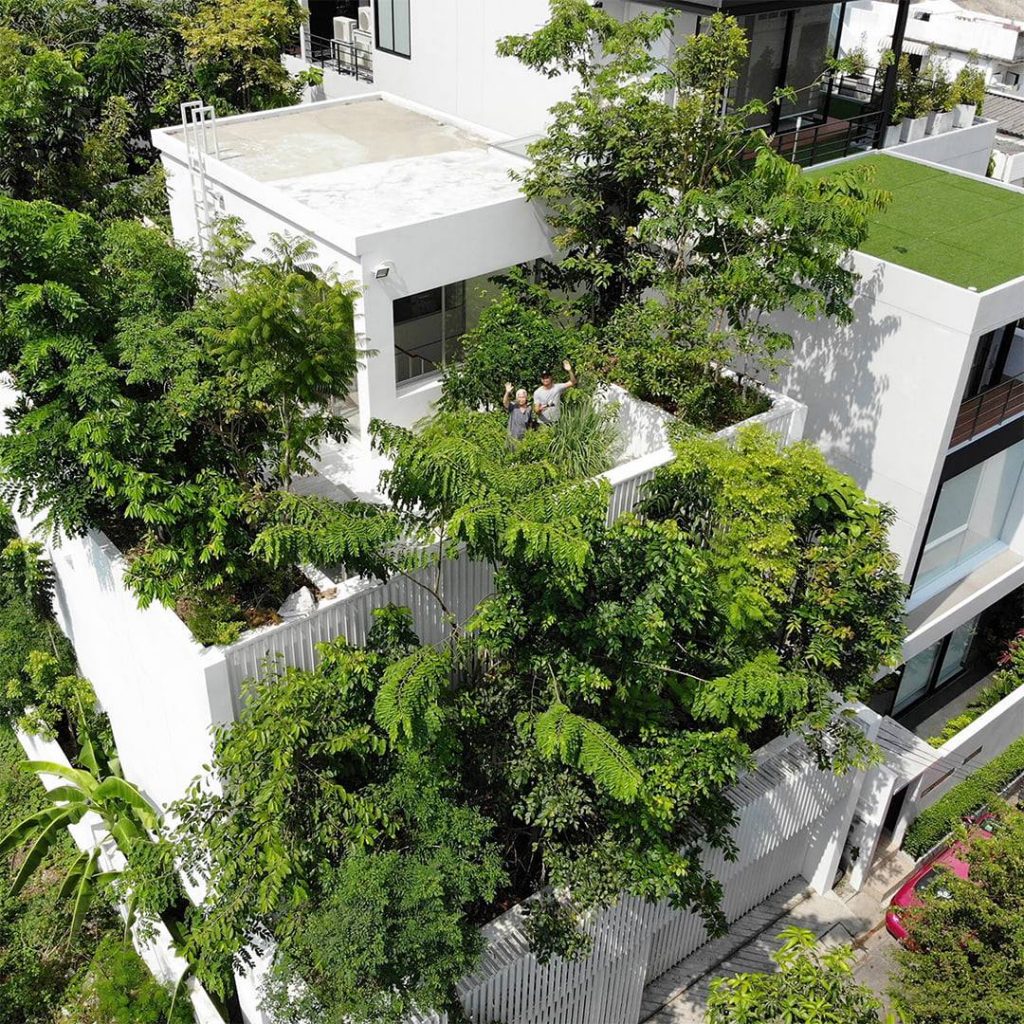
2 Forest House
.
[Please scroll down for English Translation]
.
Forest House เป็นตัวอย่างของโครงการที่ให้ความสำคัญกับความเป็นไบโอฟีลิค เห็นได้ชัดจากความตั้งใจที่จะเพิ่มพื้นที่ธรรมชาติให้กับพื้นที่อยู่อาศัยให้ได้มากที่สุด บ้านหลังนี้มีพื้นที่คอร์ดสองส่วน คั่นระหว่างพื้นที่ด้านในแต่ละส่วน ทำให้รู้สึกถึงแสงธรรมชาติ อุณหภูมิและอากาศ พร้อมปลูกต้นไม้กว่า 120 ต้น พื้นที่สีเขียวเหล่านี้ทำหน้าที่กักเก็บน้ำฝนและผลิตออกซิเจนให้คนในละแวกนั้นได้หายใจอย่างเต็มอิ่ม ประหนึ่งเป็นป่าขนาดย่อมที่เติบโตในเมือง จะว่าเผยให้เห็นแนวคิด Shinrin Yoku หรือการอาบป่าก็เป็นได้
.
หลังคาของ Forest House ใช้ประโยชน์จากแสงแดดเต็มที่ บริเวณนี้มีพื้นที่กระบะปลูกสูง 1 เมตร กลายเป็นพื้นที่เพาะปลูกในเมืองเล็กๆ หรือ Urban Farm สามารถเก็บเกี่ยวผลไม้และสมุนไพรไทยได้ ใช้ทำอาหารให้แก่ทุกคนในครอบครัว นอกจากนี้ยังเป็นพื้นที่ของกิจกรรมครอบครัว ให้ทุกคนมาใช้เวลาร่วมกัน ลงมือทำ Horticultural Therapy หรือพืชสวนบำบัด ซึ่งหมายถึงการเพาะปลูกพืชและการทำสวนเพื่อลดระดับความเครียดทางจิตใจและร่างกาย
—
Forest House located in the busy city of Bangkok, is an example of a Biophilic space, the need and desire to add nature to the environment. With 2 courtyards in-between each segment of the house, bringing in the sense of natural light, temperature, and air. The whole site is planted with more than 120 trees collecting rainwater and producing fresh oxygen for the neighborhood to breathe in, making the house a growing forest on its own bringing in the idea of “Shinrin Yoku” or Forest Bathing.
.
The roof is a harness of full sunlight exposure, as we’ve occupied them with 1-meter high planters for the urban farm where Thai fruits and natural herbs are grown for the entire family. This also gives the family activities to enjoy together and participate in “Horticultural Therapy”, a practice that uses plants and gardening to improve mental and physical stress.

3 Red Cross Office
.
[Please scroll down for English Translation]
.
มาถึง Red Cross Office กันบ้าง ภูมิทัศน์ของที่นี่ได้รับการออกแบบภายใต้แนวคิด “สวนที่เป็นประโยชน์ต่อผู้ใช้อย่างแท้จริง” เป็นสวนสุขภาพ (Healing Garden) เพื่อผู้ป่วยและผู้สูงอายุ โดยมีเป้าหมายเพื่อสร้างกิจกรรมและปฏิสัมพันธ์
.
ภายในโครงการได้ใช้หลักการ Universal Design เป็นหัวใจหลักของการออกแบบ ออกมาในรูปแบบทางลาด มีราวจับตลอดทุกส่วน ตั้งแต่ทางเข้าจนถึงพื้นที่อาคารผู้ป่วยพร้อมการปรับระยะทั้งหมดให้สะดวกต่อการใช้งานของผู้สูงอายุ โครงการนี้ประกอบด้วย 4 โซนกิจกรรมหลักได้แก่ Flexible Lawn เป็นพื้นที่อเนกประสงค์ของโครงการที่สามารถใช้สำหรับแอโรบิคและออกกำลังกาย The Terrace เหมาะสำหรับการจัดงานปาร์ตี้ เต้นรำ และร้องเพลง The Courtyard พื้นที่รวมตัว และ Active Lawn ใช้เป็นพื้นที่อเนกประสงค์สำหรับการออกกำลังกาย
.
นอกจากนี้ยังมีการจัดวางโซนนิ่งแตกต่างกันไปตามระดับความเป็นส่วนตัวของผู้ใช้งาน ดังที่มีสนามหญ้าหรือที่นั่งแบบกลุ่มสำหรับคนจำนวนมากในโซน Cabana Gazebo ที่นั่งเป็นกลุ่มและน้ำพุในลานภายในเป็นพื้นที่ปลดปล่อยความเครียด น้ำพุจะช่วยทำหน้าที่ดึงดูดความสนใจผู้ป่วยจากความเครียดได้ดี รวมถึงระเบียงที่นั่งทั้งแบบกลุ่มเล็กๆ และที่นั่งเดี่ยวเพื่อผู้ที่ต้องการใช้เวลาส่วนตัว
.
ส่วนบริเวณทางเข้าอาคารนั้นก็ยังตกแต่งด้วยสวนดอกไม้ ช่วยเสริมสร้างบรรยากาศสบายและความประทับใจ มีการปลูกไม้หอมและพืชที่เป็นเอกลักษณ์บริเวณนี้และตรงที่จอดรถ ในขณะที่ด้านหลังอาคารมีพื้นที่แปลงผลไม้และสวนสมุนไพรเหมาะสำหรับการทำกิจกรรม “Horticultural Therapy” หรือ พืชสวนบำบัดด้วยเช่นกัน
—
The landscape of the Red Cross was designed under the theme of “The Park is truly beneficial to users.”, a healing garden for patients and elders targeting activities and interactions.
.
Universal design is used as the center of the design for basic usage. Ramps and railings are provided from the entrance sidewalk through to the patients building, all dimensions were adjusted to relate to the elders. This project is an ensemble of 4 main activity zones; Flexible Lawn, the multipurpose area of the project that can be used for aerobic and exercise, The Terrace, a party, dancing and singing area, The Courtyard, a gathering area, and Active Lawn, used as the flexible area for exercise.
.
We’ve also taken into consideration levels of privacy patients need through different settings in each area. Active lawn or group seating for a large number of users is available in the Cabana Gazebo. Group seatings and fountains are added in the courtyard as a stress-released area, the fountain addresses directed attention and acts as a distraction from stress. The terrace area is available for smaller group seats or individual seats for those who want to spend time alone.
.
The design of the arrival court consists of flowering plantations to create a good atmosphere for first impressions. Entrances and car parks are planted with fragrant flowers and symbolic plants. The back of the building lies fruits and herbs plotting, which allows for “Horticultural Therapy”.
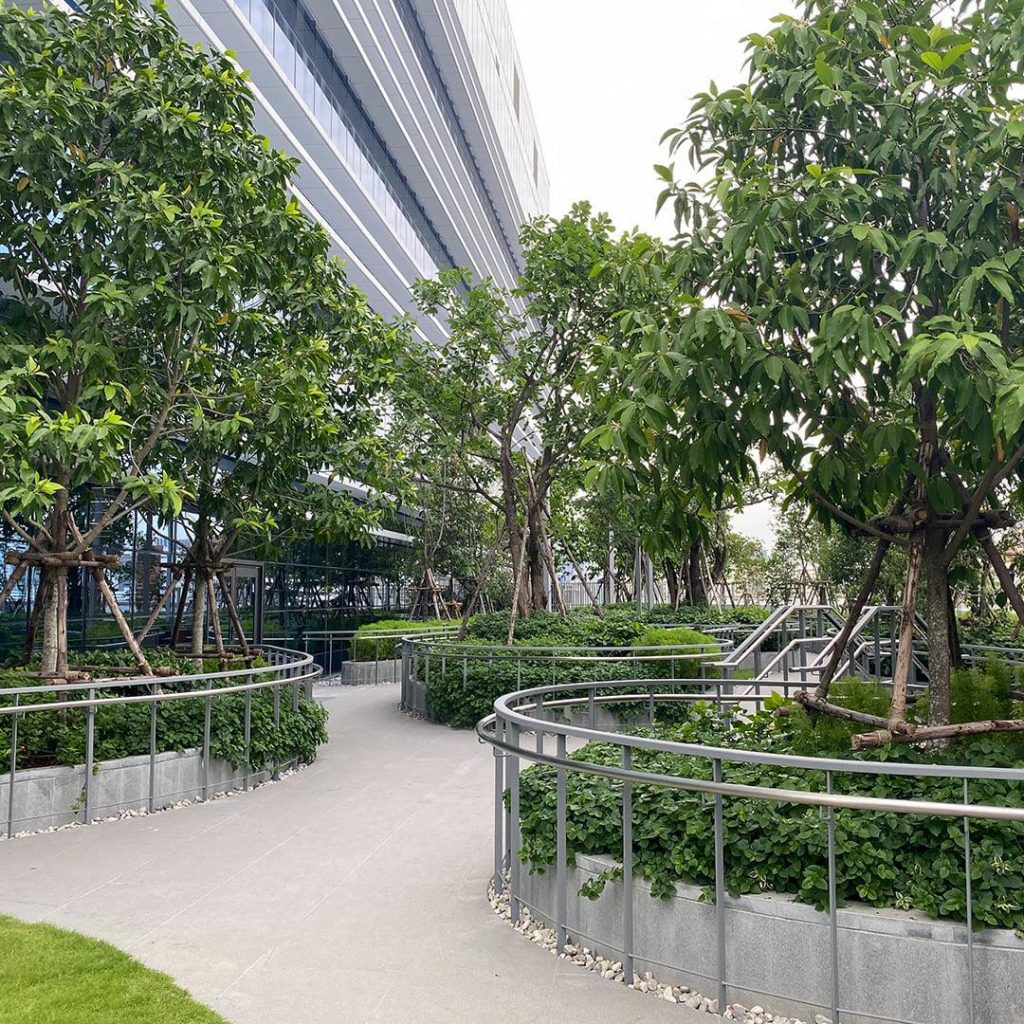
4 Med Park Hospital
.
[Please scroll down for English Translation]
.
Med Park Hospital เป็นโรงพยาบาลเอกชนแห่งใหม่ ศูนย์กลางทางการแพทย์ของเอเชียตะวันออกเฉียงใต้ การออกแบบภูมิทัศน์เป็นไปตามแนวคำขวัญของโรงพยาบาล “ทุกชีวิตมีความหมาย” ในขั้นตอนการออกแบบได้มีการวิจัยค้นคว้าเกี่ยวกับการดูแลสุขภาพ ภูมิทัศน์บำบัด และ Universal Design สะท้อนออกมาเป็นองค์ประกอบต่างๆของภูมิสถาปัตยกรรม ไม่ว่าจะเป็นทางลาด ราวบันได ทางเดินแบบไม่มีขั้นบันได พื้นผิว สี และการเลือกใช้พืชพรรณ
.
บริเวณชั้น 5 ที่เป็นชั้นของคลินิกกระดูกและข้อ และสปาเพื่อการฟื้นฟู ภูมิทัศน์สวนกลางแจ้งของชั้นนี้ถูกออกแบบให้รองรับกิจกรรมฟื้นฟูสมรรถภาพ ทำหน้าที่เป็นสวนส่งเสริมทางการแพทย์ (Therapeutic Garden) ห้อมล้อมด้วยร่มเงาและต้นไม้สีเขียว ตัวสวนประกอบด้วยพื้นที่พักผ่อน พื้นที่ออกกำลังกาย และสิ่งอำนวยความสะดวกสำหรับการพักฟื้น พื้นผิวต่างๆถูกออกแบบให้เหมาะสำหรับการเดินและการฟื้นฟูร่างกายของผู้ป่วย ควบคู่ไปกับทางลาดมีราวจับตามหลัก Universal Design อีกทั้งยังมีพื้นที่พักผ่อนที่มีแสงสว่างเพียงพอสำหรับผู้สูงอายุ ผู้ป่วย และพนักงานอีกด้วย
—
Med Park Hospital is a Brand-new Private hospital, the medical hub of Southeast Asia. As the Hospital motto “Life Does Matter”. The landscape design is based on several deep research, healthcare design, therapeutic landscape, and universal design approach, such as ramps, railings, step-less, tactile pavement, textures, colors, and plant selection. All are well-considered and applied properly in all areas.
The 5th floor is the home of the orthopedic clinic and rehabilitation spa, the garden on this floor is utilized for outdoor rehabilitation activities. The garden is full of greenery, provides shade for users with a soft natural light to the building. The garden acts as a therapeutic garden encouraging a sense of healing with relaxing space, exercise space, and rehabilitation facilities with various floor textures for walking to help patients in physical recovery along with thoughtfully universal design, providing ramps, railing, resting area with sufficient light for elderly, patients, and also staffs as well.
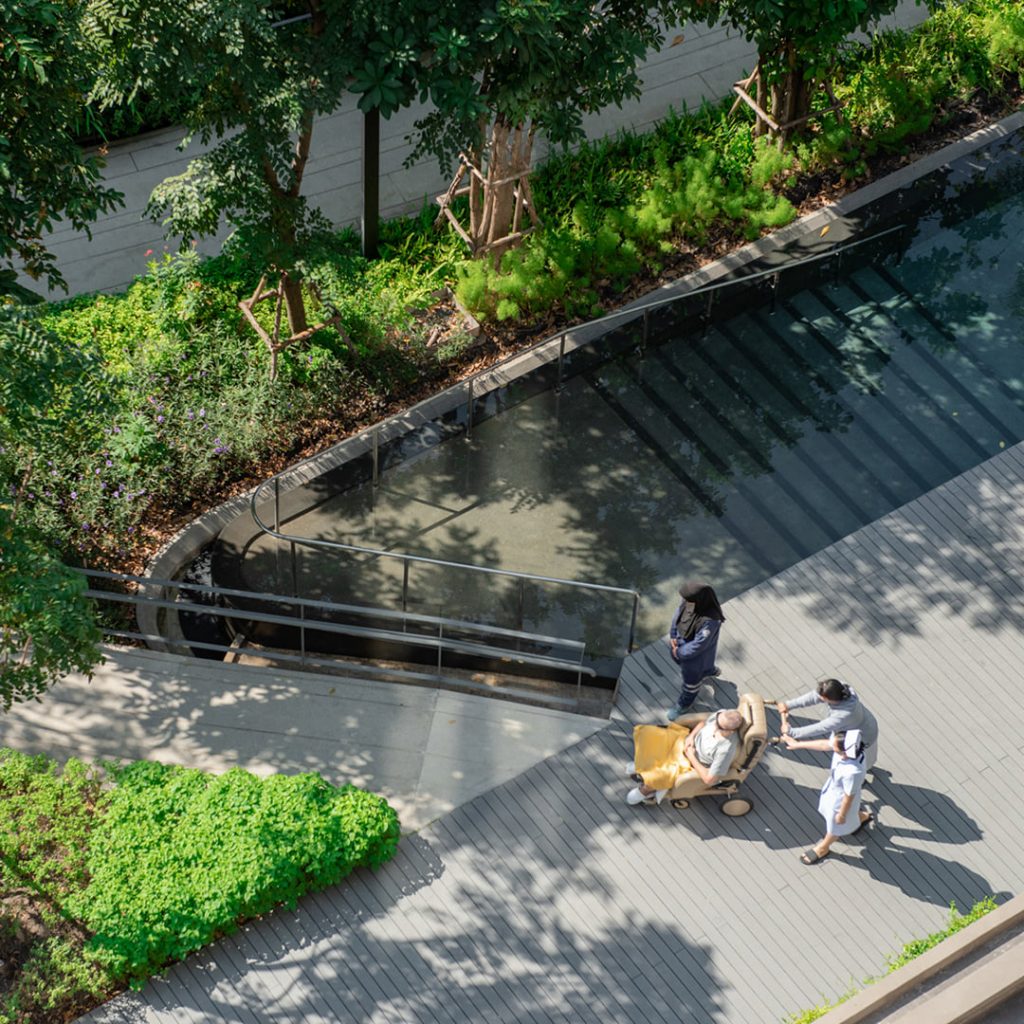
5 Jin Wellbeing County
.
[Please scroll down for English Translation]
.
Jin Wellbeing County คือโครงการที่ผสมผสานระหว่าง สวนสุขภาพ (Healing Garden) และสวนส่งเสริมทางการแพทย์ (Therapeutic Garden) ตอบรับโลกและสังคมไทยที่กำลังก้าวเข้าสู่สังคนผู้สูงอายุเป็นอย่างดี Jin Wellbeing County เป็นโครงการ mixed-use แห่งแรกของประเทศไทยที่เน้นกลุ่มเป้าหมายเป็นผู้สูงวัย ได้รับการออกแบบตามแนวคิด The Seven Dimensions of Wellness เพื่อสร้างภูมิทัศน์ชุมชนริมลำน้ำ
.
การออกแบบสากล (Universal Design) เป็นหนึ่งในไฮไลท์สำคัญ ทุกพื้นที่ทั้งหมดล้วนเชื่อมต่อกันด้วยทางลาดทั้งสิ้น มีราวจับตลอดแนว ให้ผู้สูงอายุและผู้พิการสามารถเดินเล่นได้อย่างปลอดภัย รถพยาบาลสามารถผ่านได้อย่างง่ายดายยามฉุกเฉิน มีการจัดวางที่นั่งทุกๆระยะ 30-50 เมตรให้ผู้สูงอายุสามารถนั่งพักได้ มีการใช้วัสดุพื้นผิวหยาบเพื่อลดความเสี่ยงของการลื่นไถล และติดตั้งแสงสว่างที่เพียงพอสำหรับการใช้งานในเวลากลางคืน
.
ภายในโซนสวนบำบัด (Therapeutic Garden) อันเป็นสถานที่ฟื้นฟูหลักของโครงการ ได้รับการออกแบบให้ผู้ใช้งานสามารถบริหารประสาทสัมผัสทั้งห้าได้ พร้อมตกแต่งด้วยสายพันธุ์ต้นไม้มีสีสันและกลิ่นหอม มีเส้นทางพิเศษสำหรับกายภาพบำบัด แบ่งออกเป็น 3 รูปแบบ – ทางเรียบ ทางลาดชัน และ ขั้นบันได ที่ติดตั้งด้วยราวจับทั้งหมด เอื้อให้ผู้ดูแลเดินไปด้วยกันได้และกระตุ้นให้พวกเขาสุขภาพแข็งแรงขึ้น
.
ในภาพรวม การจัดวางพื้นที่ทั้งหมดเป็นไปในแนวทางที่ช่วยส่งเสริมการพบปะของผู้ใช้งาน ให้พวกเขาได้สามรถปฏิสัมพันธ์กันผ่านกิจกรรมต่างๆได้ มีลานออกกำลังกายและแนวที่นั่งริมน้ำ อีกทั้งยังมีที่นั่งเกาะกลุ่มที่ให้ความเป็นส่วนตัว โต๊ะกลางแจ้งท่ามกลางความเขียวขจี รวมถึงสวนผักกินได้ พร้อมโซนนั่งเล่นรับประทานอาหาร ที่สามารถจัดเวิร์คช็อปเพื่อการเรียนรู้ได้ด้วย
—
Jin Wellbeing County is a combination of Healing Garden and Therapeutic Garden. As many parts of the world are becoming an aging society, ‘Jin Wellbeing County’ has become the first senior-oriented mixed-use development in Thailand. All aspects of “The Seven Dimensions of Wellness” are embedded in the landscape design to truly achieve “Community in the Ravine Forest.”
As ‘Universal Design’ is another main priority, all programs are connected with ‘All-ramp access,’ sloping up and down with equipped handrails and no additional steps. These pathways allow seniors and handicaps to stroll around safely. An ambulance can also easily pass through during an emergency. Seatings are placed at every 30-50 meters distance along the paths, where the elderly can take a rest from time to time. Rough surface materials are used to reduce the risk of slippering, along with adequate lighting for nighttime usage.
The Therapeutic Garden encourages users to exercise their five senses – sight, hearing, taste, smell, and touch to achieve holistic health, among colorful and fragrant species. There are special trails for physical therapy designed in 3 patterns – flat road, slope path, steps. All are equipped with handrails, allowing caretakers to walk together and encourage them to rebuild their strengths.
To create ‘engagement,’ space planning is designed to add a ‘chance of meeting,’ encouraging cross activity interaction such as exercise area and enclaves of gathering spots along the creek. Yet, there are also private seating niches and secluded outdoor tables among greenery, offering a sense of ‘retreat.’ After all, an edible garden allows to ‘create’ some dining and workshop together, leading to lifelong learning.

